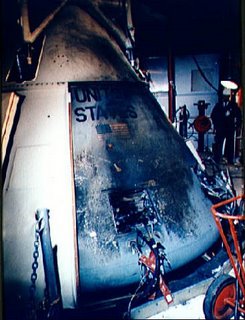
These astronauts were selected to be the first manned flight of an Apollo capsule to orbit the earth. Their mission was to take have taken place sometime in the first quarter of 1967. The purpose of this flight was to test launch operations, ground tracking and control facilities and the performance of the Apollo Saturn rocket. On January 27, 1967, the crew was in the middle of a launch simulation test when the fire broke out thanks to a spark from frayed electrical wire.
I did a little googling and some research from a couple books I have about the Apollo program and here is a recap of this horrible event.
Failure Is Not An Option by Gene Kranz
A Man On The Moon by Andrew Chaikin
First Man: The Life Of Neil A. Armstrong by James R. Hansen
Grissom, White and Chaffee were fully equipped and suited when they entered the Apollo capsule around 1:00 PM. They were strapped into their seats and hooked up to the capsule's systems. There was a problem with Grissom's space suit that delayed the tests for almost two hours. At 2:45 PM, the capsule hatch was sealed and the air already in the capsule had begun to be replaced by pure oxygen. Other problems included an alarm about high oxygen flow, faulty communications between the crew and the mission control room. These delayed the tests another three hours.
During the delay, the crew members were reclining in the capsule couches, running through a checklist of things they would do in space. Once this was completed, a plugs out drill (test of the capsule's internal back up power if the main source failed) was in process when at 6:31 PM a voice was heard in mission control "We've got fire in the cockpit." Seconds later, communications ended with a cry of pain. On the television monitors, Astronaut Ed White was seen attempting to open the hatch, which had sealed shut.
From Hansen's book, "A spark from the frayed wire jumped into some combustible material, likely foam padding or velcro patches. In the 100 percent oxygen atmosphere, even a momentary flicker-which in the open air would have ignited only into a small and easily controllable flame-became a firebomb. In the choking white heat, the three astronauts died from asphyxion in a matter of seconds, their respiratory systems not waiting for their bodies to be incinerated in the 2,500 degree farenheit furnace."
They never had a chance. Seventeen seconds from the first call of "Fire!" all three men were dead.

This tragedy led to a redesign of the Apollo capsule. Among the changes was the hatch would open outward (not inward like Apollo 1) and be operable in less than ten seconds. Flammable materials in the cabin were replaced with self-extinguishing materials. Plumbing and wiring were covered with protective insulation. Nylon spacesuits were replaced with coated glass fabric suits, which proved to be much more difficult to ignite.
The wiring improvements saved the crew of Apollo 13 as condensation that accumulated during the four day power shut-down of their command module did not cause any short circuits when they powered up prior to their re-entry.
1 comment:
Good write up. Sent you a comment a few days ago but must have posted it wrong.
I remember this well.
Mom
Post a Comment